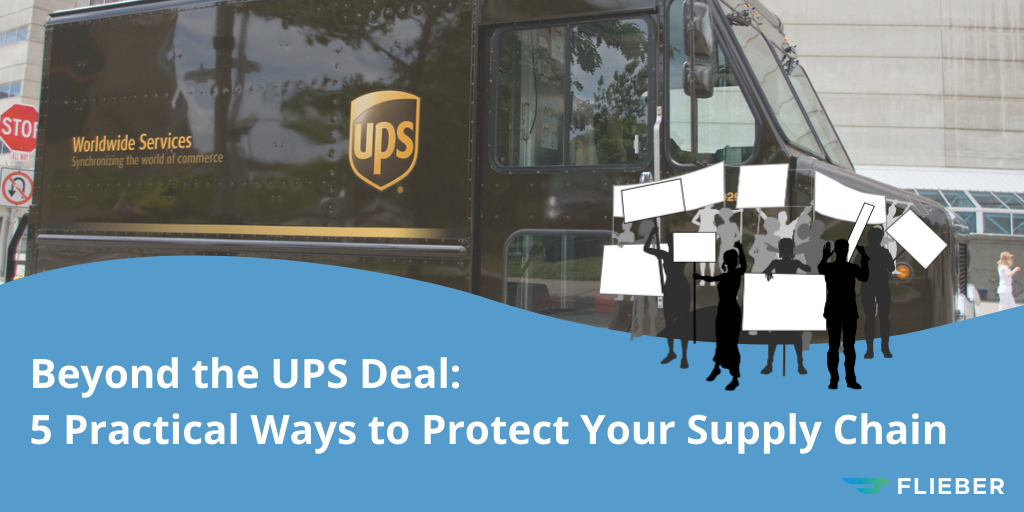“We demanded the best contract in the history of UPS, and we got it.” Those are the words of Teamsters General President Sean M. O’Brien in a recent release announcing the historic UPS contract agreement.
Last month, 340,000 UPS workers said they were prepared to walk off the job if contract negotiations were not complete by July 31. Fortunately, a “game-changing” new agreement — to the tune of $30 billion for pay raises, more full-time jobs, and dozens of new workplace protections and improvements — was reached on July 25.
With UPS now handling nearly a quarter of US parcel deliveries, the threat of a strike delivered a stark wake-up call for consumers, brands, and retailers. While the retail community may have dodged the bullet this time, this groundbreaking development could signal further strikes and lasting changes to the e-commerce supply chain.
Let’s take a closer look at the events that led to this monumental agreement, and ways to increase control of your supply chain to protect your business moving forward.
What does the UPS deal mean for retailers?
- The UPS deal signals a new standard in the labor movement
- Why now is the time to strengthen your supply chain
- 5 practical ways to protect your brand
“A new standard in the labor movement”
UPS and the Teamsters have the largest private sector union agreement in the US. In early July, talks stalled between UPS and the Teamsters Union, which represents about 340,000 of the parcel service’s roughly 500,000 total full- and part-time workers.
The union voted — with 97% percent in favor — to authorize a strike if an agreement wasn’t reached by July 31, 2023, when the union’s current contract was set to expire. In early July, negotiations came to a halt as both UPS and the Teamsters accused one another of “walking away” from the bargaining table.
UPS and the Teamsters resumed negotiations during the last week of July, reaching an historic tentative agreement of roughly $30 billion dollars.
The landmark deal includes:
- Higher wages
- More full-time jobs
- Equal pay
- MLK Day as an official holiday
- Part-time rewards
- Air conditioning for drivers
In the summer of 2022, UPS teamsters began a viral campaign to share extremely high temperature readings from inside their trucks on social media. That same August, the union announced a call to action to begin mobilizing for the new contract currently under negotiation.
While the deal was over a year in the making, the landmark agreement comes at a pivotal moment in US history.
Across the country, a wave of similar labor uprisings, including the SAG-AFTRA and Writers Guild of America strikes and the California hotel workers protest have put increasing pressure on large employers. Labor strikes across the country increased by 50% from 2021 to 2022 signaling a new era in labor agreements.
Meanwhile, a June 2023 Supreme Court ruling could make it easier for companies to sue unionized workers for damages suffered during organized labor activities, which could deter workers from unionizing or engaging in protest activity.
Though the future impact of the agreement has yet to be seen, there are clear implications for the retail supply chain.
An urgent call to strengthen your supply chain
According to consulting firm Anderson Economic Group, the UPS strike would have been the most expensive in the last century or more. The cost to the US economy could have surpassed $7 billion, with UPS customers potentially losing over $4 billion.
“This strike is a serious threat to the US economy,” AEG President Patrick Anderson told CNN Business in early July. “The degree to which the US economy has become dependent on fast delivery of small items that can be carried by UPS hasn’t really been tested.”
In 2022, UPS says it delivered an average of 24.3 million packages per day — an amount much higher than any of its competitors would have been able to absorb. That same year, FedEx — its next closest competitor by revenue — delivered only 6.21 million packages per day.
“There isn’t a single company on the planet that can handle 24 million shipments a day that UPS manages,” Mike Parra, CEO of the Americas for DHL express, told FreightWaves.
Regardless of how much volume other carriers can take on, the impact of a UPS strike would have been devastating for retailers.
Slow delivery times, higher prices on products and shipping, and a supply chain breakdown to rival 2020 are just some of the consequences the retail community would have seen if a deal had not been reached.
But this doesn’t mean retailers are out of the woods. Experts like Alex Colvin, dean of the School of Industrial and Labor Relations at Cornell, told The Atlantic that positive results for UPS Teamsters would “send a strong message to workers organizing at places like Amazon about union representation”. Teamsters president Sean O’Brien has been vocal about its intent to help Amazon workers unionize.
According to Supply Chain Dive, the companies most vulnerable to future strikes will be those who haven’t made advance arrangements for alternative carriers, as well as those without enough “volume and financial muscle to compel other carriers to make extra room in their networks at the last minute.”
Retailers need to act now to establish relationships with alternative carriers and diversify their logistics.
5 ways to protect your brand
With the UPS agreement signaling a strong likelihood of future strikes, it's important to plan for ways to minimize the impact on your business.
Here are some ways to start preparing.
1. Review, adjust, and optimize your inventory levels
In the event of a strike, brand operators will need to increase their lead times and start planning even earlier to cope with slower delivery.
Shipping delays won’t just mean late deliveries for your customer — they could also keep raw materials from getting to your manufacturers and suppliers, and your products from getting to your warehouses. You may need to stock up on extra product to keep filling orders, while avoiding an inventory glut if you’re unable to ship goods out.
According to a 2021 McKinsey report on building a “shock-proof” supply chain, “Navigating the manifold disruptions will require retailers to maintain an end-to-end visibility… Implementing a digital control tower that connects data systems and generates insights across the end-to-end supply chain can create transparency and accelerate response times.”
Partnering with an advanced inventory optimization platform like Flieber can help bring all of your supply chain data under one roof, giving you deep insight into all sales channels and inventory locations, empowering you to plan for — and adapt to — a potential strike.
- Demand Planning: Customizable forecasting uses your existing demand planning methods, while leveraging artificial intelligence to predict future sales, while accounting for anomalies like strikes, low inventory, and stockouts.
- Inventory Planning and Replenishment: Armed with a more accurate forecast, you can create a customized plan to optimize your existing inventory, increase lead times on the right products, and stay on top of replenishment — even in the face of strike-related supply chain disruptions.
- Visibility Across Sales Channels: Flieber works with all the platforms you use to sell, including Amazon, Shopify, and BigCommerce.
2. Diversify your shipping options
Now is the time to start reaching out to a wider range of carriers.
Here are some of the options to consider:
- The United States Postal Service: USPS's new ground shipping product, Ground Advantage, is said to be increasing the postal service’s day-to-day shipping capacity. Announced July 10th, the program consolidates several legacy USPS services, and claims to reduce prices.
- FedEx: The company — which has seen its share of the parcel market decline as UPS and Amazon’s logistics have grown — may be moving to seize opportunities in the wake of further strike threats. Fedex has already said that it would prioritize existing large customers, and customers looking to work with them should “shift business immediately.”
- DHL: The global shipper has taken a more conservative approach, and claims the company “hasn’t benefited from shipper concerns” about a possible strike. The company offers expedited express shipping via courier, as well as a suite of e-commerce shipping options.
3. Prioritize critical shipments
From getting enough seasonal inventory in stock on time to making sure loyal, high-volume channels don’t see major delivery delays, you’ll need to carefully rank and prioritize the shipments that matter most in the event of a future strike.
Here are some options to consider:
- Expedited Order Processing: Moving critical orders to the head of your queue could reduce customer wait times even if delivery stalls. You could also offer faster order processing for free to loyal customers, or charge a small fee for those willing to pay.
- Use Alternative Carriers for Critical Shipments: Be prepared to start shifting high-priority orders to other carriers in the event of a potential strike. Even if prices are higher or you can’t shift all your business, your most important shipments may be less impacted. Consider shortlisting critical orders for alternative transportation options (more on this below).
- Keep an Eye on Your Data: With Flieber’s 360° view of sales, inventory, and supply chain data, you can keep a close eye on your most important shipments and make adjustments in real-time to keep them on-track.
4. Consider alternative transportation options
In addition to shifting some of your business to other large parcel delivery services, you could look at diversifying your delivery options to include alternative models of transportation.
- Crowd-sourced and Gig-based Solutions: Roadie (now owned by UPS), Doordash, Postmates, Shipt, and Uber could be options for local last-mile. In some areas, pilot local delivery programs could even include robots, drones, and self-driving vehicles.
- E-Commerce Solutions: Third-party logistics solutions like Ohi and Flexe can offer specialized same-day and next-day delivery for e-commerce. A word of caution as you explore: Many of these providers still rely on large-scale carriers like UPS for some of their business.
- Courier Services: Other more specialized or local courier services may be able to pick up some slack, but there’s no guarantee they’ll be able to handle the volume you need.
- LTL: Less than truckload shipping could be another strong backup option, though it’s already a bit slower than an ordinary shipment. LTL marketplaces, like Cargomatic and shuddl, can help you compare options.
- Self-Delivery: If you have the resources, consider bringing some deliveries in-house. You could invest in a small private or dedicated fleet.
5. Communicate with customers
Perhaps the most important thing you can do to stay on top is keep your customers in the loop.
- Set Expectations: If a strike occurs, post about it on your landing page and flag it on all your product listings. Make sure it’s immediately clear to customers, before they make a purchase, that their order could be delayed and why. This will let them know what to expect, and prevent disappointment in your brand if an order is delayed.
- Provide Real-Time Tracking Updates: If you’re not doing it already, make sure your customers are receiving real-time updates on the status of their shipments. Let them choose between email or SMS formats, or even a tracking app.
- Respond Promptly to Queries: With supply chain insight from a partner like Flieber, you can give customers even more detailed information about where their orders are and when they’re likely to arrive. Giving them more visibility into the process can ease frustration and help them feel more in-control. Offering discounts in tougher cases can’t hurt, either.
Future-proof your supply chain with Flieber
While there is no crystal ball for predicting future strike threats, there are still practical steps you can take to strengthen your supply chain.
With real-time visibility and powerful machine-learning based forecasting on your side, Flieber can help you stay one step ahead of disruption.
Schedule a demo to learn how Flieber works today, so you can be ready no matter what happens tomorrow.



-1.png)

